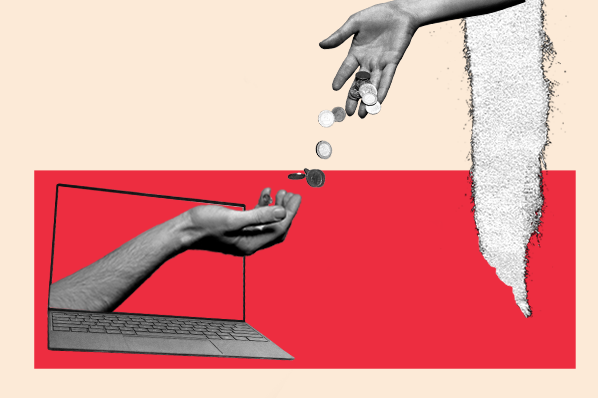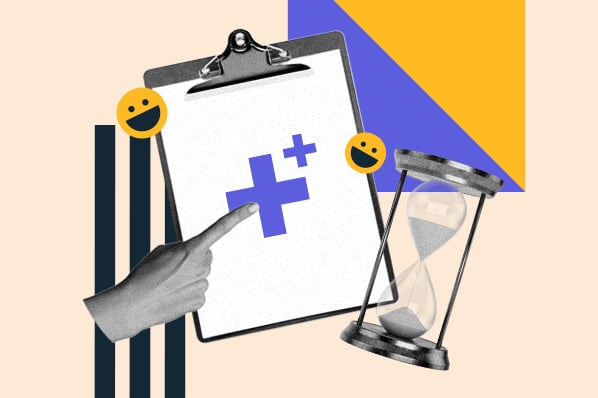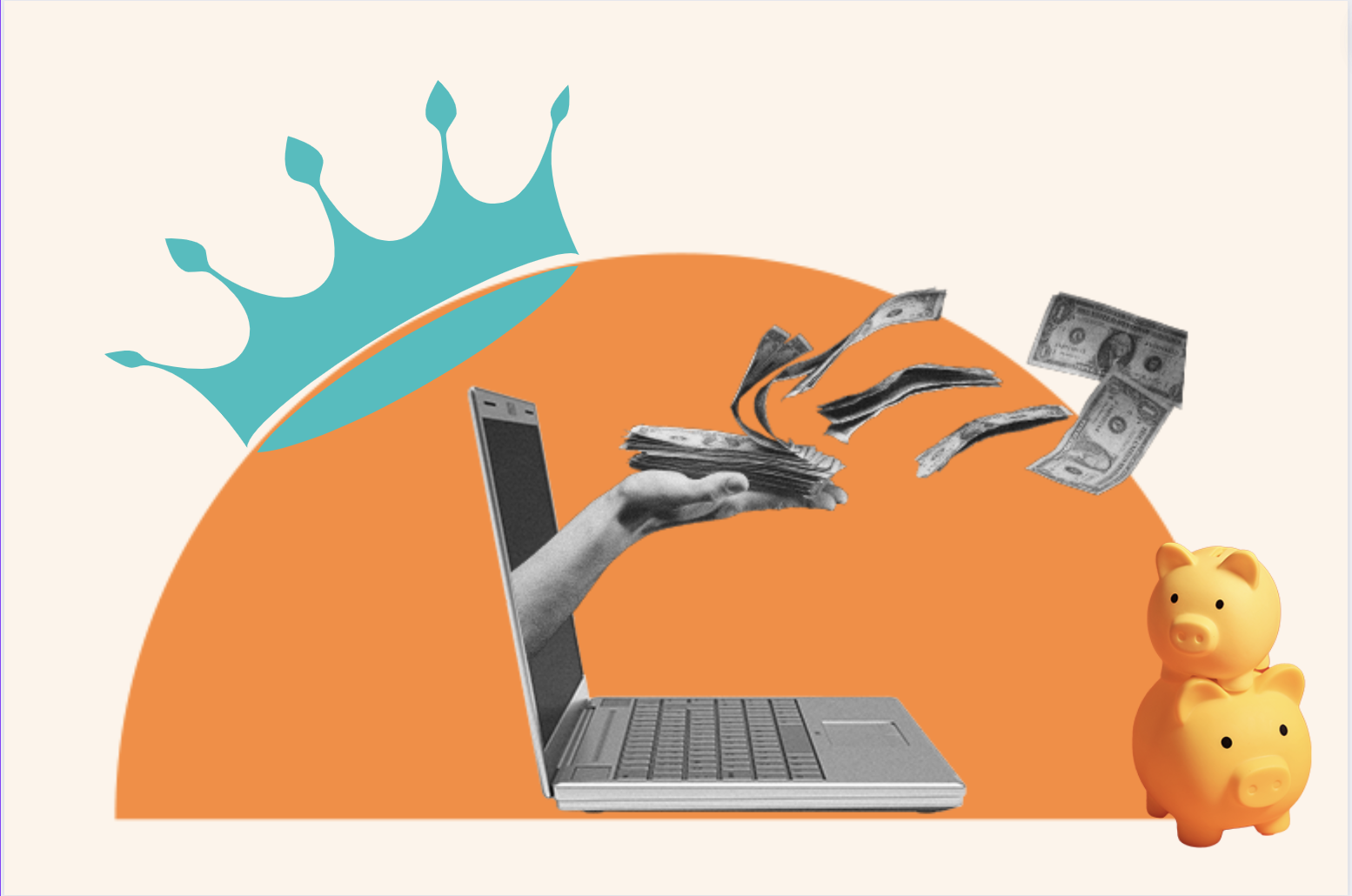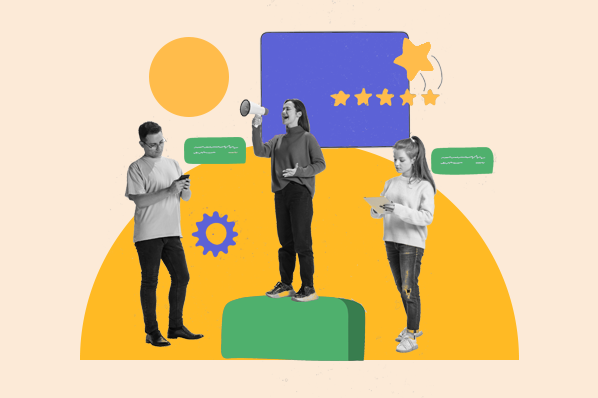Ninety-five percent of marketers found that their email marketing strategy was effective at driving business goals — including customer retention. Not only are customer retention emails cost-effective, but also they help increase brand loyalty, reduce customer churn, and generate more revenue for your business.
In this article, you'll learn what customer retention emails are, why they matter, and how to write them. Then, you can get inspired by real-life examples of effective customer retention emails.
Table of Contents
- What is a customer retention email?
- Why Customer Retention Emails Matter
- Customer Retention Email Examples
- Tips for Writing Customer Retention Emails
- Retaining Existing Customers with Email Marketing
What is a customer retention email?
Customer retention emails are sent to existing customers to encourage them to continue using your product. Retention emails come in different forms, but they are all designed to communicate the value of your product and keep existing users loyal to your brand.
Customers may have signed up for your product, bought something from you before, or simply visited your website. Whatever action they took, retention emails are meant to remind them of their interaction with you and to let them know that you value them.
Why Customer Retention Emails Matter
Retaining customers is as important as acquiring new ones. Customer retention emails can play a huge role in re-engaging past buyers before they churn. Common benefits of customer retention emails follow.
1. You'll save money.
Whenever you lose an existing customer, you'll end up spending more trying to replace them. Over 70% of respondents agree retaining customers costs less than acquiring new buyers.
Sending customer retention emails can encourage buyers to stick with your brand. Re-engaging these customers will help you reduce customer acquisition costs.
2. Customer retention emails keep your brand top of mind.
The popular saying "out of sight is out of mind" applies perfectly in business.
When a customer signs up, subscribes, or buys from you, you should regularly keep connected. Customer retention emails remind buyers of how your offering can improve their lives. If a customer engages with you once and they don't ever hear from you again, they'll likely forget about you.
Lotus Felix, founder of LotusBrains Studios, understands this all too well. "For me, maintaining a 'value-adding' presence in my customer's inbox is core to retaining brand relevance," he says. "Customers are not guaranteed to use your product/service if you don't regularly show up and serve them."
3. Existing customers are more likely to buy from you.
Most people prefer to buy from a brand they're familiar with instead of one they've only heard of. The success rate of selling to an existing customer is 60-70%, according to Market Metric. Meanwhile, the success rate of closing a new customer is only 5-20%.
What's more, the value of a loyal customer multiplies when they tell other people about your business. Think about your favorite pizza place. How often have you taken your friends there? How many times have you recommended the place to others?
A loyal customer is a gift that keeps on giving.
"The most valuable customers are the ones you have, that can refer you to their peers, colleagues, or industry connections," says Deniz Kuran, head of marketing at Idiomatic. "Don't make the mistake of pursuing new business and neglecting the customer base you've built."
4. Customer retention reflects customer satisfaction.
Low turnover rates (or churn) indicate that your customers are satisfied with your brand, products, or services. You'll know doing things right when it comes to acquiring customers, delivering great customer service, and building brand loyalty.
Customer Retention Email Examples
To show you what great customer retention emails look like, we've collected email examples from brands that are successful at keeping loyal customers.
1. Welcome Emails
Sending a welcome email is your chance to make a good first impression with brand-new customers or subscribers. Here, you can introduce yourself, explain more about your product, and forge a relationship with buyers.
Plus, welcome emails have an open rate of 50%. This means that recipients are 75% more likely to read them than other marketing emails.
Here's a great example of a welcome email from Asana.

What we love: With its headline "A better way to work awaits," Asana makes you anticipate a more streamlined way of managing projects. Underneath the celebratory graphic, Asana delves right into guiding you, a new user, on how to get started with their product.
Before giving some starter tips, Asana tells the new user to expect regular emails. This sets the tone for future communications. Underneath the tips, Asana tells you what to do before your trial period ends to ensure that you continue receiving value.
2. Feature Announcement and Product Update Emails
Customers churn when they feel they're not taking advantage of product offerings. That's why you should send emails announcing new features and product updates.
Those emails should contain an explanation of what the new features or updates are, as well as how customers can get value from them.
Canva does a great job with its feature announcement emails.

"What's new in Canva?" is a simple headline that immediately tells you that Canva has updated its offerings. No bells or whistles.
What we love: In the email itself, Canva introduces each new feature with its name and a short GIF of how the feature works. Underneath the GIF, Canva explains what you can do with each feature. Notice how they first identify your problem with a question and then position each new feature as the solution to your problem.
3. Promotional Emails
Promotional emails allow you to reward loyal customers through discounts, extra offers, or early access. In return, you get more sales.
If you're looking for a role model, check out this promotional email from Grammarly.

What we love: The second you open this email, the huge, orange-colored "45% off a year of premium" jumps at you. After grabbing your attention with this massive discount, Grammarly explains why you should claim this offer.
To increase appeal, Grammarly lists all the new features (and values) that will be available to you once you claim the offer.
4. Cart Abandonment Emails
An abandoned cart doesn't always mean that a customer isn't interested in buying anymore. It might mean that they've forgotten or they were distracted before checkout. Remind them with a cart abandonment email.
This customer retention tactic is incredibly effective. Businesses that send cart abandonment emails earn back 3%-14% of those sales, according to Klaviyo. The report also found an average revenue of $5.81 per returning customer.
This cart abandonment email by Society6 is a great example.

What we love: The preview text of this email — "Order Incomplete" — lets the recipient know that they did not check out. Then, Society6 informs the recipient that their cart will be available for two more days. Then they offer the recipient 30% off on the abandoned cart.
But Society6 does not stop there. Below the discount CTA button, there are links to other Society6 products — armchairs, throw pillows, and wall tapestries. This is Society6's way of saying, "Hey, since you'll get 30% off this cart, why don't you just add more stuff to it and get a discount for everything?"
Society6 has mastered both the art of retention and the upsell.
6. Reminder Emails
Your customers are people with real-life responsibilities, so it's only normal that they're not thinking about your brand 24/7. That's why reminder emails exist.
Whenever your customer is approaching an important date, like the end of a trial period, a subscription renewal, or an upcoming webinar, you should send them a reminder email.
These emails should be persuasive and polite. They serve a gentle nudge — not a shove — in the direction that you want them to go.
In her newsletter, email conversion strategist Samar Owais gave a great example of a reminder email she got from TinyPNG.

Owais appreciated this reminder email.
"TinyPNG isn't an expensive service. It costs $25/year. A small amount in the grand scheme of things, but enough to irritate me when it would've shown up as an unexpected expense in my statement," she says. "But because they sent me a reminder email a week before they charged my card, I was aware and prepared for the expense. I knew it was coming, and I could decide whether I wanted to stick around or not."
Spoiler alert: She stuck around.
What we love: This email is short and direct. It lets Owais know that her subscription is going to automatically renew at a fast-approaching date. Then they have an eye-catching bright green CTA that takes Owais to her account page, just in case she needs to change her settings, stop the renewal, or update her payment details.
7. Thank You Emails
Most businesses exist to make money, but no one wants to feel like a living, breathing dollar sign. People want to be appreciated. Sending a thank you email post-purchase shows a customer that they matter beyond just the sale.
Send thank you emails when customers:
- Pay or purchase something from you.
- Register for an event.
- Send a referral.
- Make inquiries.
- Subscribe to your newsletter.
- Renew their subscription.
- Give feedback.
You can take things up a notch by sending thank you emails randomly. This culture of customer appreciation goes a long way toward building a brand that people love and remember.
Here's a great example of a thank you email by Abercrombie & Fitch:

In this simple but elegant email, Abercrombie & Fitch expresses their gratitude to customers that trust them with their style.
What we love: Notice how there are no images or CTA buttons in the email. Here, direct conversions are not the goal. The goal is to let customers know that Abercrombie & Fitch does not take their patronage for granted.
8. Special Occasion Emails
Few things make a person feel more valued than remembering special occasions. That can be a birthday, holiday, or anniversary. Sending personalized special occasion emails shows that you care. Even better if you include a gift or discount in the email.
The clothing company Rent the Runway sends amazing birthday emails.
What we love: In this email, Rent the Runway (RTR) wishes their customer a happy birthday and gifts them 25% off their next order. RTR takes things to the next level by suggesting some beautiful outfits the recipient can buy with their discount.
9. Feedback Emails
Customer feedback is invaluable. The success of a business depends largely on the customers' perception.
Think of customer feedback like data. If the feedback is positive, you can use it as social proof. If it's negative, you'll learn where you're going wrong so that you can improve and grow. Either way, you win.
Plus, customers appreciate when you ask them about their opinion of your brand, products, or service. It shows that you're striving to create the best possible product for their needs.
Here's an example of a great feedback email from Nest.

What we love: In this email, Nest asks existing customers for their thoughts on the Nest Thermostat. They make it clear that they take their customers' answers and opinions seriously.
Because the customer can see that Nest continuously tries to improve, they may feel compelled to hit the bright orange CTA button in the middle of the email and take the survey.
10. Milestone Emails
You can send milestone emails to existing customers to celebrate their achievements while using your product. Your email encourages the customer to keep crushing their goals and makes them feel like they're a part of a community that's looking out for them.
For an impeccable milestone email, check out Duolingo.
What we love: Duolingo sent me this rundown of my activity in the app in the past week. Here, I can see my streak count, time count, a chart comparing this week's activity to last week's, and the breakdown of words and phrases I learned. This helps me see how much progress I'm making with my Spanish lessons.
I put more effort into my lessons every day just to see the XP level increase when I get my milestone email at the end of the week. That's how great these emails are.
11. Customer Engagement Emails
Let's be clear: Every email you send should foster customer engagement. But here, we're talking specifically about emails that provide value to your customers by suggesting content or product features that are relevant to their needs.
These emails go deeper than a customer's billing cycle or latest buy. The content of customer engagement emails is usually personalized. They're based on the way the customer interacts with the business.
Netflix does a great job of this.

What we love: The best thing about these emails is that Netflix tailors movie and TV show suggestions to each subscriber — as you can see from their headline "For Althea." Netflix studies my actions on their app and suggests content based on what I have watched on the platform.
12. Interactive Emails
Interactive emails contain functional elements that allow customers to take action right in the email. These emails allow customers to:
- Fill out and submit forms.
- Watch videos.
- Shop products.
- Complete surveys.
- Participate in quizzes.
- Play games.
- Register for events.
- Book demos.
Interactive emails are effective because they encourage customers to engage. The higher the engagement, the better the retention.
Note: Any customer retention email can be an interactive email.
Vitamin retailer Bulk does interactive emails well.

What we love: In this email, Bulk asks for feedback on five of their summer flavors via a colorful survey that recipients can take right inside the email. To convince their customers to take the survey, Bulk offers a lucky voter a chance to win a pouch of all five flavors (not just the one they voted for).
Pretty good incentive, if you ask me.
13. Win-back Emails
Win-back emails are designed to bring back customers that have churned or stopped interacting with your business. These emails combine reminders, product updates, discounts, and other tactics to convince your former customer to give you a second chance.
Crafting an effective win-back email requires you to know everything you possibly can about the churning customer.
"If you're a good marketer or business owner, you must know tons of information about a specific person who stopped using your product," says Irina Maltseva, growth lead at Aura. "It's not just about their name and email. It's about user experience, business goals, and problems. The more information you have, the easier it would be to win back the customer."
This email by Avocode is one of the best win-back emails I've seen.

What we love: Avocode starts with a question that directly calls out the reason the customer churned: slow service. Then they state that they've spent the last four months improving their design speed.
Although they make it clear that it's the customers' choice to give their product another try, Avocode assures them that they'd be happy with the changes made to the app. To top it off, Avocode offers a 20% discount, should the churned customer choose to reengage.
Tips for Writing Customer Retention Emails
Now that you know your email options, here are some tips that can help you write any type of customer retention email.
1. Focus on the basics.
To successfully retain your customers, you need to know them inside and out. Fancy language and beautiful design won't help if you lack basic customer insight.
"Think about a) where the customer is in their journey, b) what their frustrations are (collect qualitative data to understand this), and c) how your communications will solve these frustrations," says Alex Birkett, the co-founder of Omniscient Digital.
The contents of your emails should depend on your customers and their needs.
2. Get the subject line right.
The subject line is the first thing your customers see when they receive your email. This short phrase or sentence determines whether your customer opens the email or not.
To increase open rates, your subject line has to be catchy and concise. Subject lines should communicate the content of your email, and, if possible, your product's value.
"You have to convey a sense of importance and urgency without sounding spammy or desperate," says Corey Haines, the co-founder of SwipeWell. "If it never gets opened, it never has the chance to get someone back into the app and reengage."
Using his own company as an example, Haines notes: "Here's an example of what we send at SwipeWell if someone hasn't made any 'swipes' within the last seven days."

The subject lines for that email — since it's sent four times in a drip sequence — are:
- Hmm, no swipes last week?
- Keep building your swipe file 💪
- You didn't make any new swipes last week 😢
- It's been a while since you swiped anything to SwipeWell.
Looking for more information? Here are some tips for writing catchy email subject lines.
3. Personalize your emails.
The most effective email subject lines include promotions that are personalized to each customer's interests, according to HubSpot Marketing Industry Trends.
Personalizing your customer retention emails can mean sending targeted messages to different user groups or segments of your email list. Personalization also means giving customers loyalty discounts, offering birthday greetings, or sending thank you emails on their anniversaries of using your product.
You can also use insights about specific customer products or interests to personalize the promotional offers you're sending them. This increases the chances of them claiming the offers.
"We produce hilarious custom animated videos related to our clients' businesses and periodically email them," says Felix of LotusBrains Studios. "By entertaining our customers in our customer retention emails, we renew our rent in their minds for the next few weeks/months. This way, when they need a service related to our industry, we top their list of consultations."
4. Communicate product value.
Before HubSpot acquired PieSync, the team at PieSync implemented a new customer retention email campaign that helped them decrease churn by 21% and increase net revenue retention by 115%.
Ruben Camerlynck, former head of growth at PieSync, attributed these impressive results to communicating product value in the emails.
"[The key is to] either highlight the value customers are already getting from your product or try to get them to activate another feature of your product so they get more value," says Camerlynck.
Anytime you send an email to customers — especially the ones on the brink of churning — let them know the pain points you can help them solve, what differentiates you from your competition, and how they can get the most value from your product.
5. Tell stories.
Humans love stories. So help your customers relate to you and see the humanity behind your business by telling them a story. It can be your business' origin story or stories about how your customers have helped you improve your business.
Bani Kaur, a freelance writer at Klaviyo, is a fan of including stories in retention emails.
"People love human stories, especially when the stories center them," Kaur says. "For example, in your email, you could write, 'Your purchases have allowed us to add a new intern to our social media department. Diana is a vibrant, witty, and fiercely ambitious lady from London, and she's working doubly hard to make our Instagram account enjoyable.'"
This approach is more effective than simply telling your customers that you're constantly improving your product. Here, you're showing them what you're doing to improve customer experience.
6. Have a compelling CTA.
Call-to-action (CTA) buttons in retention emails indicate to the recipient what they should do next. All the real-life emails we analyzed above had CTA buttons that were designed to grab the attention of the customers. Apart from the attractive buttons, the calls to action themselves were compelling and direct. Some examples include:
- Get started.
- Try Pro for free.
- Claim your 40% off.
- Take our survey.
- Continue learning.
- View more.
- Add to cart.
7. Build feedback loops.
To build a successful business, you need to listen to what your existing customers have to say about your product. A great way to get their opinions is to build feedback loops in your emails. These feedback loops help you understand what makes your product valuable, and also why people churn.
Just like Nest's email above, send surveys to both existing and churned customers to find out why they chose to continue (or stop) using your product.
Retaining Existing Customers with Email Marketing
Acquiring new customers is important, as is nurturing existing customers.
We've outlined 12 customer retention email types above. Not all of them will be relevant to your business — and that's okay. The most important thing is that your customers' journeys, pain points, and desired solutions fuel the emails you send.
.png?width=112&height=112&name=Image%20Hackathon%20%E2%80%93%20Vertical%20(67).png)



![7 Customer Acquisition Challenges You Might Face This Year [New Data]](https://www.hubspot.com/hubfs/customer%20acquisition%20%20%281%29.webp)




![Big Brands That Lost Customers' Satisfaction in 2023 [Where CX Went Wrong + Data]](https://www.hubspot.com/hubfs/companies%20that%20lost%20customers_featured.png)


![How to Calculate Churn Rate in 5 Easy Steps [Definition + Formula]](https://knowledge.hubspot.com/hubfs/ai%20customer%20service%20predictions%20%283%29.webp)
